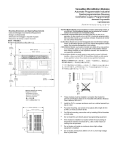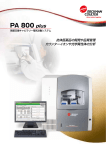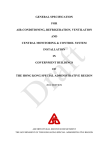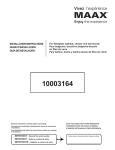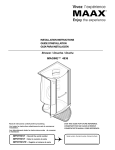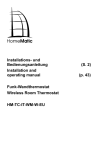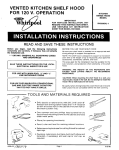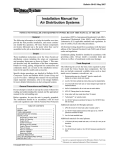Download installation and start-up instructions
Transcript
installation and start-up instructions MA1A MH1A 10 SEER RESIDENTIAL SELF-CONTAINED AIR CONDITIONER/HEAT PUMP UNITS Cancels: New II MA1A-18-1 12-95 NOTE: Read the entire instruction manual before starting the installation. SAFETY CONSIDERATIONS Improper installation, adjustment, alteration, service, maintenance, or use can cause explosion, fire, electrical shock, or other conditions which may cause personal injury or property damage. Consult a qualified installer, service agency, or your distributor or branch for information or assistance. The qualified installer or agency must use factory-authorized kits or accessories when modifying this product. Refer to the individual instructions packaged with the kits or accessories when installing. Follow all safety codes. Wear safety glasses and work gloves. Read these instructions thoroughly and follow all warnings or cautions attached to the unit. Consult local building codes and the National Electrical Code (NEC) for special installation requirements. Recognize safety information. This is the safety-alert symbol . When you see this symbol on the unit or in instructions and manuals, be alert to the potential for personal injury. Understand the signal words DANGER, WARNING, and CAUTION. These words are used with the safety-alert symbol. DANGER identifies the most serious hazards which will result in severe personal injury or death. WARNING signifies hazards which could result in personal injury or death. CAUTION is used to identify unsafe practices which would result in minor personal injury or product and property damage. Fig. 1—Model MA1A/MH1A WARNING: Before installing or servicing system, always turn off main power to system. There may be more than 1 disconnect switch. Turn off accessory heater power if applicable. Electrical shock can cause personal injury or death. A95337 TABLE 1—UNIT SIZES AND AVAILABLE ELECTRIC HEAT UNIT SIZE 018 024 030 036 INTRODUCTION The MA1A Air Conditioner and MH1A Heat Pump are UL Listed per Standard UL 1995/UL 559 for use in manufactured homes. These units are available in the cooling sizes shown in Table 1. The MA1A and MH1A are single package units. All components including outdoor coil, compressor, and refrigerant tubing are located in 1 single package. The units are already piped, charged, and wired. Refer to Fig. 2 for basic unit dimensions. BTUH COOLING 18,000 22,000 28,000 34,600 AVAILABLE KW 0—5—10 0—5—10 0—5—10—15 0—5—10—15—20 I. UNPACK UNIT AND INSPECT EQUIPMENT Remove unit from carton and inspect for any shipping damage. Do not install a damaged unit. Optional components used with unit may include a thermostat, base and roof assembly kit, fresh air kit, or return-air grille and air filter assembly. Remove pallet by removing 4 bolts attaching pallet to base of unit. CAUTION: The condensate drain outlet protrudes from base of unit. To avoid damage to floors and floor coverings, unit must be transported on an appliance dolly. Do not slide unit on floor. Transport unit on appliance dolly from side or rear only. Transporting unit from front will damage air intake grille and lower coil. When setting unit onto base template, unit may be carefully tilted from front by a hand truck. INSTALLATION These units were designed for installation in manufactured homes, but can be installed in a variety of other applications. These instructions detail the method of installation for use in manufactured housing or other similar applications. Fig. 3 illustrates a typical installation of this type. Study this drawing prior to starting installation. It may be helpful to refer back to this drawing during installation. Consult your distributor and the Application Guideline document for details regarding other installation applications. —1— 11 9⁄16″ 7 7⁄16″ 5 1⁄4″ 10 3⁄8″ 6 7⁄16″ 4 5⁄8″ ROOF OUTDOOR-AIR EXHAUST 8 9⁄16″ 10 11⁄16″ WALL THERMOSTAT 9 3⁄8″ 5 3⁄4″ 14″ INSULATED FLEX DUCT 4 3⁄4″ 4 15⁄16″ THERMOSTAT WIRES FROM THERMOSTAT BLOCK 14-IN. ROUND BLOWER TOP SCHEME NO. 1 20″ BLOWER TOP SCHEME NO. 2 25″ PRIMARY ELECTRICAL SUPPLY CONNECTIONS ROOM AIR INTAKE AND FILTER OUTDOOR-AIR PLENUM INDOOR PLENUM INDOOR SUPPLY DUCT CONDENSATE DRAIN HOSE (PIPE TO OUTSIDE OF STRUCTURE) H A95338 NOTE: If a door is used to enclose unit, refer to "Installation of Unit Behind a Louvered Door or Enclosed in Closet" in Setup section. Fig. 3—Typical Installation 12 3⁄4″ 3 11⁄16″ 1 13⁄16″ • 8 No. 10 X 1/2 rust-resistant, self-tapping sheet metal screws (holding roof flashing). • Permanent sealant such as "mastic." • 4 wood screws (base template). • 2 No. 8 X 3/4 wood screws (unit to floor). Do not overtighten and compress seal. • Silicone caulking (roof flashing) • Thermostat cable (18 gage wire minimum). NOTE: The number of conductors needed depends on type of unit and thermostat being installed. Air conditioning units require 4- or 5-conductor wire depending on type of thermostat being used. (Some thermostats require a C terminal connection for proper operation.) Heat pump units require 6-conductor wire. 6 13⁄16″ 9 3⁄4″ 9″ 18 9⁄16″ DRAIN 5 1⁄2″ 1 1⁄32″ 18″ A95358 DIMENSIONS (IN.) UNIT SIZE 018 024 030 036 H 57 57 67 67 BLOWER TOP SCHEME Scheme No. 2 Scheme No. 2 Scheme No. 1 Scheme No. 1 CAUTION: Do not use thermostat wire with less than the recommended number of conductors. Fig. 2—Unit Reference Drawing CAUTION: Failure to adhere to indoor air, outdoor air, and exhaust air requirements as listed in the following sections will void unit warranty. II. ASSEMBLE SUPPLIES NEEDED FOR INSTALLATION The standard method of installation for units in manufactured homes is with accessory base and roof assembly kit. NOTE: If installing any other kit, Installation Instructions will be furnished with kit. In addition to items included in base and roof assembly kit, the following items are required to install unit. All sizes listed are suggested. • Adhesive duct tape, U.L. 181 aluminum or equivalent. III. SETUP A. Indoor-Air Duct Requirements The MA1A and MH1A units are designed to be installed in 1 of the following ways: 1. Installed flush with the wall. (See Fig. 4.) WARNING: Incorrect type of duct tape may be a fire hazard. A failure to follow this warning could result in a fire or explosion, and personal injury or death. 2. Recessed behind a louvered door. (See Fig. 5.) 3. Installed in a closet with 1 or 2 return-air grilles. (See Fig. 6.) Refer to Installation of Unit Behind a Louvered Door or Enclosed in Closet section for grille sizes. —2— REMOVABLE WALL PANEL FOR UNIT'S SERVICE REMOVABLE TRIM FOR UNIT'S SERVICE (DO NOT GLUE) OPTIONAL LOCATION NOTE: THE UNIT MUST BE ACCESSIBLE FOR SERVICE. A95339 Fig. 4—Unit Installed with Front Exposed A95341 Fig. 6—Unit Installed in Closet with Return-Air Grille CAUTION: The minimum installation clearance between both the indoor-air plenum and first 2 ft of metal duct to any combustible material is 1 in. (See Fig. 7.) The remainder of unit and duct work is approved for 0-in. clearance. INDOOR-AIR COLLAR (12 11⁄16″ X 8 15⁄16″ X 9 1⁄4″ DEEP) OUTDOOR-AIR PLENUM (5 7⁄16″ X 17 15⁄16″ X 19 1⁄4″ DEEP) 251⁄4″ 203⁄4″ DRAIN CUP NT O FR F O IT UN BASE TEMPLATE 24″ METAL AIR DUCT FOAM SEAL 24″ A95340 Fig. 5—Unit Installed behind a Louvered Door B. NOTE: DO NOT OBSTRUCT OUTDOOR-AIR PLENUM OPENING. Indoor Supply Air Duct A95342 The MA1A and MH1A units are designed to operate at a given static pressure. The duct system, regardless of size, must not exceed 0.3 in. static pressure. The design and construction of duct system must also provide adequate air distribution to ensure comfort levels throughout home. If unit is being installed to replace another furnace or heating system, a check of airflow rate (CFM) should be performed. If airflow rate does not meet specifications, duct alterations or repairs must be made to correct airflow problem. Fig. 7—Indoor-Air Plenum and Duct Clearances C. Recommended Unit Clearances For serviceability and elimination of compressor vibration transmission, it is recommended that the sides and back of unit be installed with a minimum 1-in. clearance from walls. It is also recommended that top of unit be installed with a clearance large enough to allow removal of unit should it be necessary. —3— D. Installation of Unit Behind a Louvered Door or Enclosed in Closet WALLS 191⁄2″ 181⁄2″ IT PREPARE FLOOR AND BASE A. Install Installation Kit FLOOR FLOOR JOIST FRAMING HOME DUCT TRUNK A95344 Fig. 9—Dimensions of Hole FOAM AIR SEAL FLAT-HEAD WOOD SCREW INDOOR AIR COLLAR Installing installation kit requires a hole through floor of home approximately 18-1/2 in. wide by 19-1/2 in. deep to provide access from unit to supply duct trunk and outside air. NOTE: The diagrams show a typical installation. The actual method of installation will be dictated by model and manufacturer of the home. Installer will determine the best method to use. DO NOT USE FRONT INSIDE HOLES OUTDOOR AIR PLENUM BASE TEMPLATE BEND ALTERNATE TABS INDOOR AIR CUTOUT 13″ x 91⁄8″ 1. Construct a boxed-in area of framework under unit location slightly larger than the 18-1/2-in. by 19-1/2-in. hole to provide adequate support for unit. (See Fig. 8.) DUCT TRUNK FLOOR JOIST ≈181⁄2″ UN APPROX. 8″ NET FREE OPEN AREA (SQ IN.) 300 375 450 IV. F TO ON FR TABLE 2—MINIMUM RETURN-AIR REQUIREMENTS UNIT SIZE 018 024 030, 036 2″ 2″ TYP. If unit is installed behind a louvered door and louvers are directly in front of unit’s intake grille, a 2-in. clearance is recommended between door and front of unit. If louvers are installed in upper part of door so they are not directly in front of intake grill, a minimum 7-in. clearance is recommended between door and front of unit. This also applies if a solid wall is used instead of a louvered door. Should the louver be installed somewhere other than in front of unit (for example, to the side of unit), consult your distributor before proceeding to obtain recommended clearances. The recommended minimum return-air requirements to be used are shown in Table 2. DRAIN CUP 91⁄8″ 13″ DRAIN HOSE (PIPE TO OUTSIDE OF STRUCTURE) NOTE: THE DRAIN CUP, FOAM AIR SEAL, OUTDOOR-AIR PLENUM, AND INDOOR-AIR COLLAR ARE PREASSEMBLED AT FACTORY. ≈191⁄2″ A95345 Fig. 10—Installation of Base Template, Indoor-Air Collar, and Outdoor-Air Plenum CAUTION: Be careful not to crimp drain hose attached to condensate drain cup. SUPPLY-AIR DUCT CAUTION: Failure to route drain hose where it will not be kinked will cause drain trap to overflow, leaking water onto floor. A95343 Fig. 8—Typical Framework Construction 5. Remove base template assembly. Reach through hole and cut holes through vapor barrier and insulation for outdoorair plenum and condensate drain hose to extend through or drain to outside. Also cut 13-in. by 9-1/8-in. hole in duct trunk. (See Fig. 10.) 2. Locate supply duct trunk so that it runs under front edge of hole. Back edge of supply duct trunk should be approximately 8 in. from back of hole. (See Fig. 9.) 3. After floor section is complete; locate, mark, and cut a hole through floor approximately 18-1/2 in. by 19-1/2 in. (See Fig. 9.) 6. Bend every other tab up 90 degrees on indoor-air collar as shown in Fig. 10. 7. Insert base template assembly into supply duct and secure it with 4 flat-head screws, 1 in each corner. Bend remaining tabs up 90 degrees locking indoor-air collar securely to supply duct trunk. Use mastic or foil-type duct tape to seal any openings. (See Fig. 10.) 4. Place base template assembly over hole and mark indoor-air plenum cutout in supply duct trunk measuring 13 in. by 9-1/8 in. (See Fig. 10.) Mark condensate drain hose and outdoor-air plenum cutouts in insulation and vapor barrier or drain to outside. —4— NOTE: Do not let indoor-air collar extend down into duct. It MUST be flush with top of duct trunk. If collar does not fit properly, minor adjustments may have to be made to collar. 8. Use Flex-Mend or equivalent RTV caulk to seal bottom board to outdoor-air plenum. TEMPORARILY COVER HOLE WHILE THE 15-IN. CUTOUT IN THE CEILING AND ROOF ARE BEING MADE WARNING: Non-foil-type tapes will not withstand the temperature of heated air from unit and may be a fire hazard. Failure to tape joint will allow heated or cooled air to leak beneath home. A failure to follow this warning could result in a fire or explosion, and personal injury or death. WOOD SCREWS V. INSTALL UNIT A. Setting Unit CAUTION: Do not move unit on an unprotected floor. Damage to floor will result. 1. If necessary, use an appliance dolly to position unit into enclosure, being careful not to disturb foam seal on template. When unit’s front edge is in line with front edge of base template, set unit upright onto base template. (See Fig. 11.) NOTE: SCREW HOLES IN BOTTOM RAIL OF UNIT MUST ALIGN WITH HOLES IN METAL BASE TEMPLATE. A95348 Fig. 12—Securing Unit to Floor 4. Cover unit top as shown in Fig. 12. Cut a hole with a diameter of approximately 15 in. through ceiling and roof directly over outdoor-air exhaust. If hole in roof and ceiling cannot be aligned directly over each other, a small bend in the flexible duct may be required. Acceptable misalignment of hole in ceiling and transition is a maximum of 2 in. per each 12 in. of flex duct in elevation, up to a maximum of 6 in. 5. Seal any opening with mastic to prevent loss of conditioned air into attic space. B. Exhaust Air Venting 1. Apply a generous amount of mastic to roof surface and around hole cut for outdoor-air duct to pass through. (See Fig. 13.) Lower duct down through hole in roof and ceiling and fasten flashing to roof with screws. APPLY MASTIC TO SEAL ROOF CAP TO ROOF BASE TEMPLATE 15-IN. DIAMETER HOLE NOTE: TILT UNIT APPROXIMATELY 45° WHILE MOVING IT INTO PLACE TO AVOID DISTORTION OF FOAM SEAL. A95347 Fig. 11—Setting Unit on Base Template CAUTION: Only minor movement is allowed when aligning holes in unit base with holes in template to prevent damage to foam air seal. ROOF 2. Remove front grille of unit (if necessary) as shown in Fig. 12 and make minor adjustments in location of unit if necessary to align screw holes in bottom rail of unit with screw holes in base template. 3. The unit should be secured permanently to structure by driving 2 wood screws through mating holes in bottom rail of unit and base template into floor. Tighten screws flush to foam seal. Overtightening screws will tip unit forward on foam seal. Do NOT use any other procedure to permanently secure unit to structure. CEILING A95349 Fig. 13—Outdoor-Air Duct Installation 2. Apply additional mastic or sealant around flashing perimeter base to provide protection against rainwater leaking under flashing. —5— CAUTION: Failure to properly seal flashing to roof will result in rainwater leaking into and damaging unit or home. Proper sealing of roof vent is the responsibility of installer. VI. MAKE ELECTRICAL CONNECTIONS A. Electrical Requirements WARNING: To prevent personal injury or equipment damage, always disconnect main power before doing any maintenance or wiring. A failure to follow this warning could result in electrical shock, fire, or death. 3. Check fit where flexible duct passes through ceiling. Seal any openings with foil-type duct tape or caulking to prevent loss of conditioned air to attic or attic air leaking into home. (See Fig. 14.) NOTE: All electrical power supply conductors serving unit must be copper. The circuit breakers or fuses used for branch circuit protection should be UL Recognized. If circuit breakers are used, the circuit breaker for compressor circuit must have a UL HACR rating. If fuses are used, the fuses for compressor circuit MUST be a time delay. ROOF CAP ROOF All electrical wiring supplying unit must comply with the NEC ANSI/NFPA 70, and all state and local codes. ROOF FLASHING Depending on auxiliary heater size, unit must be supplied with 1, 2, or 3 separate 240-v circuits from home’s circuit breaker panel or fuse box. Refer to Table 3 and Table 4 for required circuits and recommended wire size for each circuit. CEILING TAPE APPLIED TO SEAL HOLE IN CEILING The unit is equipped with circuit breakers enclosed in wiring compartment. This compartment is located in top right-hand corner of unit. Ground wires for supply circuits must be attached to ground lug(s) in circuit breaker box to provide required safety grounding of unit. WARNING: The cabinet must have an uninterrupted or unbroken ground according to National Electrical Code, ANSI/NFPA 70 or local codes to minimize personal injury if an electrical fault should occur. This may consist of electrical wire or conduit approved for electrical ground when installed in accordance with existing electrical codes. A failure to follow this warning could result in an electrical shock, fire, or death. A95350 Fig. 14—Roof Cap Installation 4. Remove protective cover from top of unit and inspect fan housing to make sure no debris is in fan housing. 5. Push insulation up on lower end of flexible duct. Slip flexible duct onto round adapter duct on top of unit and secure duct to outdoor-air exhaust with mastic or U.L. 181 tape. NOTE: An untaped or poorly taped joint will leak outside air into home. All excess flex duct must be cut off and remaining duct pulled tight. WARNING: Failure to adhere to minimum wire sizes, maximum over-current protection, disconnect, and grounding requirements can cause personal injury, electrical shock, or a fire hazard. All wiring MUST comply with requirements of the NEC, state, and local codes. 6. Pull insulation down over taped joint and outdoor-air exhaust. (See Fig. 15.) Fasten insulation in place with tape and strap. All low-voltage thermostat wires MUST be connected to lowvoltage terminal block mounted on left side of control box located inside front panel of unit. PULL INSULATION AND OUTER COVER SNUG TO TOP OF UNIT AND FASTEN WITH STRAP-TYPE DUCT CLAMP. CAUTION: Power supply must be nominal 230-v, 1 phase. Do not exceed 253v or go below 197v. SCREW B. Electrical Connections WARNING: To avoid personal injury or death, do not supply power to unit with compressor terminal box cover removed. IF POSSIBLE, INSERT A METAL SCREW W/FLAT WASHER ABOVE WIRE FRAME OF FLEX DUCT TO HELP HOLD IT ON ROUND ADAPTER. 1. Remove front panel. a. Remove 2 screws on bottom. b. Remove 5 screws holding cover around breakers and remove it to gain access to wiring compartment. (See Fig. 16.) A95351 Fig. 15—Securing Insulation —6— TABLE 3—COMPRESSOR ELECTRICAL DATA UNIT SIZE COMPRESSOR AMPS OUTDOOR FAN AMPS INDOOR FAN AMPS 018 024 030 036 10.2 12.5 15.0 19.0 1.2 2.2 3.1 3.1 1.2 2.2 2.2 3.1 COMPRESSOR CIRCUIT AMPACITY 15.2 20.0 24.0 30.0 MINIMUM WIRE SIZE* 12 12 10 8 MAX WIRE LENGTH (FT)† 100 74 98 163 MAX FUSE‡ OR BREAKER SIZE AMPS 15 20 30 40 * If wire is applied at ambient greater than 30°C (86°F), consult Table 310-16 of the NEC (ANSI/NFPA 70). The ampacity of nonmetallic-sheathed cable (NM), trade name ROMEX, shall be that of 60°C (140°F) conductors, per the NEC (ANSI/NFPA 70) Article 336-30. If other than uncoated (non-plated), 60° or 75°C (140° or 167°F) insulation, copper wire (solid wire for 10 AWG and smaller, stranded wire for larger than 10 AWG) is used, consult applicable tables of the NEC (ANSI/NFPA 70). † Length shown is as measured 1 way along the wire path between the unit and the service panel for voltage drop not to exceed 2%. ‡ Time-delay fuse. TABLE 4—ELECTRIC HEAT ELECTRICAL DATA ELECTRIC HEATER (KW) 5 10 15 20 USED ON Unit Size 018 024 030 036 018 024 030 036 030 036 036 1ST CIRCUIT 2ND CIRCUIT Amps Ampacity Wire Size* Max Fuse† Size Amps Max Wire Length (Ft)‡ Amps Ampacity Wire Size* Max Fuse† Size Amps Max Wire Length‡ (Ft) 23.9 29.9 10 30 80 N/A N/A N/A N/A N/A 44.8 56 6 60 111 N/A N/A N/A N/A N/A 23.9 29.9 10 30 80 44.8 56 6 60 111 44.8 56 6 60 111 44.8 56 6 60 111 * If wire is applied at ambient greater than 30°C (86°F), consult Table 310-16 of the NEC (ANSI/NFPA 70). The ampacity of nonmetallic-sheathed cable (NM), trade name ROMEX, shall be that of 60°C (140°F) conductors, per the NEC (ANSI/NFPA 70) Article 336-30. If other than uncoated (non-plated), 60° or 75°C (140° or 167°F) insulation, copper wire (solid wire for 10 AWG and smaller, stranded wire for larger than 10 AWG) is used, consult applicable tables of the NEC (ANSI/NFPA 70). † Time-delay fuse. ‡ Length shown is as measured 1 way along the wire path between the unit and the service panel for voltage drop not to exceed 2%. N/A—Not Applicable VII. CIRCUIT BREAKER BOX A. INSTALL WALL THERMOSTAT General Information Select a location for thermostat about 5 ft above floor in an area where air circulation is good. Preferably an interior wall near unit’s return-air grille is the ideal location. Thermostat should not be mounted: • Close to a window, or an outside wall, or next to a door leading to the outside. • Where it may be affected by drafts or dead air spots behind doors or corners. • Close to or in direct airflow from supply registers. • Exposed to direct radiant heat from sun, lamps, appliances, or other temperature-radiating objects which may cause a false reading. NOTE: Improper location of thermostat will cause poor operation of unit. CIRCUIT BREAKER COVER FRONT PANEL B. Route Thermostat Cable All wiring for thermostat circuit must be No. 18 AWG minimum, color-coded thermostat cable and comply with NEC, state, and local codes. Refer to Table 5 for type of thermostat cable required for specific installation applications. NOTE: Heat pump can only be controlled with a 6 or more conductor, No. 18 AWG minimum thermostat cable and a heat pump compatible thermostat. If heat pump is being installed to replace another heating furnace or system, thermostat must be replaced with 1 listed in Table 5 for heat pump use, and thermostat cable must be replaced unless it is the proper type and size. If an existing thermostat is being replaced: A95352 Fig. 16—Gaining Access to Wiring Compartment 2. Connect electrical load and ground lead to unit as shown in Fig. 17. Refer to previous section for electrical requirements. All low-voltage thermostat wires must be connected to low-voltage terminal block mounted on side of control box located inside unit. 1. Turn off all power to unit. 2. Remove existing thermostat from wall. —7— NO. 10 AWG AUXILIARY 5KW HEATER NO. 1 LOAD LEADS SERVICE GROUND LUG FOR NO. 10 AWG AND NO. 8 AWG NO. 8 AWG COMPRESSOR LEADS NO. 6 AWG AUXILIARY 10KW HEATER NO. 2 LOAD LEADS 10KW 5KW ON ON ON OFF OFF OFF 60 AMP 30 AMP 40 AMP COMPRESSOR NO. 8 AWG COMPRESSOR LEADS AUXILIARY 10KW HEATER NO. 2 LOAD LEADS AUXILIARY 5KW HEATER NO. 1 LOAD LEADS A95353 NOTE: This diagram shows a typical wiring installation for an 036 unit with 15-kw heat. It may not reflect the wiring in unit. The actual wiring installation to use depends on unit and electric heat requirements. (See Tables 3 and 4.) The installer must follow NEC, state, and local codes. Fig. 17—Typical Wiring Installation 3. Disconnect wires from existing thermostat, 1 at a time. Be careful not to allow wires to fall back into wall. If installing new thermostat cable, route as follows: 1. Drill hole for cable at location selected for thermostat. 4. As each wire is disconnected, record wire color and terminal marking. 2. Remove front panel of unit. 5. Discard or recycle old thermostat. NOTE: Mercury is a hazardous waste and MUST be disposed of properly. 3. Route thermostat cable from unit’s compartment and pull approximately 6-12 in. of cable through hole drilled in wall for connection to thermostat terminals. 6. If existing thermostat cable is acceptable for application (See Table 5), proceed to Mount Wall Thermostat and Connect Thermostat Wires section. 4. Strip outer casing off area of cable pulled through wall for greater flexibility. TABLE 5—REQUIRED THERMOSTAT CABLE TYPE APPLICATION Air Conditioner Heat Pump THERMOSTAT Robertshaw (TX400-42K) TSTATPPNAC01-A TSTATPPPAC01-A Honeywell (T841A1548) TSTATPPNHP01-A TSTATPPPHP01-A NO. OF CONDUCTORS REQUIRED 18 GAGE 4 5 5 6 8 8 —8— REQUIRED CONNECTIONS G, R, Y, W R, C, W/W1, Y/Y2, G R, C, W/W1, Y/Y2, G G, R, Y, B, W2, E R, C, W/W1, Y/Y2, G, B, S1, S2 R, G, W/W1, Y/Y2, C, B, S1, S2 WIRING DIAGRAM Fig. Fig. Fig. Fig. Fig. Fig. 18 19 20 21 25 26 C. Mount Wall Thermostat and Connect Thermostat Wires 12. Set outdoor thermostat to 50°F. NOTE: Refer to Installation Instructions packaged with thermostat for additional information. Determine the type of thermostat needed for unit application and follow instructions in the appropriate section below. ELECTRONIC AIR CONDITIONING THERMOSTATS (PROGRAMMABLE AND NON-PROGRAMMABLE) ROBERTSHAW AIR CONDITIONING THERMOSTAT 1. Remove cover (friction fit) from thermostat body by gripping at top and bottom and lifting from subbase. Use extreme care not to damage working parts. 1. Open thermostat rear door (mounting base) to expose mounting holes. The base can be removed to simplify mounting. Snap apart carefully at hinge to separate mounting base from remainder of thermostat. 2. Remove subbase from thermostat body by loosening captive screws. 2. Route thermostat wires through large hole in mounting base. 3. Hold subbase level against wall in final thermostat location. Mark wall with a pencil where screws will attach subbase to wall. Use designated subbase mounting holes only. 3. Level mounting base against wall and mark wall through 2 mounting holes. 4. Set subbase aside and drill mounting holes in wall with 3/32-in. drill bit. 4. Drill two 3/16-in. mounting holes in wall where marked. 5. Route thermostat wires from hole in wall through opening in center of subbase. 5. Secure mounting base to wall with 2 screws and anchors provided, making sure all wires extend through mounting base. 6. Attach thermostat subbase to wall using mounting screws and predrilled holes in wall. NOTE: Make sure white wire on thermostat subbase is connected to A2 terminal. 6. Adjust wire length and routing to allow proper closure of thermostat. Strip each wire end no more than 1/4-in. to prevent adjacent wires from shorting together. Match and connect equipment lead wire to correct terminals of the thermostat connector. (See Fig. 19 and 20.) NOTE: All TSTAT models have no batteries and are not "power stealing." They do require 24 vac (R and C terminals) to be connected for proper operation. Thermostat will not operate without these 2 connections. 7. Strip approximately 1/2-in. of insulation off end of each wire. Connect thermostat wires to appropriate thermostat screw terminals on subbase. (See Fig. 18.) CONTROL VOLTAGE TERMINAL STRIP THERMOSTAT FAN G 24VAC HOT R COOL HEAT Y W GREEN RED YELLOW WHITE 7. Push excess wiring into wall. Seal hole in wall to prevent drafts. 8. Snap hinge back together. G 9. Turn on power to unit. R 10. Reconfigure thermostat to energize fan (G) terminal with call for heat (W). Y Since this is a self-contained unit, there is no furnace or fan coil to energize the blower when electric heat is initiated. The thermostat MUST be reconfigured to start blower when electric heat is selected (G is energized whenever W is energized). a. Non-Programmable Model W A95354 NOTE: Connect only terminals shown to thermostat. Fig. 18—Air Conditioner Circuit Connections (Robertshaw Thermostat) (1.) Enter thermostat configuration mode by pressing and holding FAN button for approximately 10 sec. The room temperature disappears and display should read "1-." Thermostat is now in configuration mode. NOTE: If FAN button is pressed again or if no button is pressed for 60 sec, thermostat will exit configuration mode and return to normal operation. To re-enter configuration mode, the FAN button must be pressed and held for 10 sec again. 8. Push excess wire back into wall. Seal hole in wall to prevent drafts. 9. Mount thermostat body on subbase with captive screws. 10. Set heat anticipator indicator (located in upper left corner of thermostat body) to appropriate value based on the heater size for unit being installed. (See Table 6.) (2.) Use up and down buttons until thermostat display reads "5-." TABLE 6—HEAT ANTICIPATOR VALUES FOR AIR CONDITIONING UNITS HEATER SIZE (KW) 0 5 10 15 20 ANTICIPATOR SETTING N/A 0.16 0.16 0.32 0.32 (3.) Press MODE button once to display current selection of ON or OFF. Factory default is OFF. (4.) Use the up or down button to change from OFF to ON. (5.) Press FAN button to exit configuration mode. NOTE: Refer to electronic thermostat Installation Instructions for more information if needed. N/A—Not Applicable 11. Install thermostat cover. Carefully align "D" shaped dial shaft with matching shaped hole in hub of setting dial, then press cover carefully on thermostat body. —9— MODEL AC PROGRAMMABLE ELECTRONIC THERMOSTAT MODEL AC NON-PROGRAMMABLE ELECTRONIC THERMOSTAT CONTROL VOLTAGE TERMINAL STRIP 24 VAC HOT R R 24 VAC COMM C X HEAT STAGE 1 W/W1 W COOL STAGE 1 Y/Y2 Y FAN G CONTROL VOLTAGE TERMINAL STRIP 24 VAC HOT R R FAN G G HEAT STAGE 1 W/W1 W COOL STAGE 1 Y/Y2 Y N/A O/W2 N/A Y1/W2 24 VAC COMM. C N/A B N/A L OUTDOOR S1 X G SENSOR A95413 CONNECTION S2 NOTE: X terminal on control voltage terminal strip must be connected to C terminal on thermostat for proper thermostat operation. A95414 NOTE: Terminals O/W2, Y1/W2, B, and L are not used on thermostat. X terminal on control voltage terminal strip must be connected to C terminal on thermostat for proper thermostat operation. An optional outdoor temperature sensor may be connected to S1 and S2 terminals on thermostat. Fig. 20—Air Conditioning Circuit Connections (Programmable Electronic Thermostat) Fig. 19—Air Conditioning Circuit Connections (Non-Programmable Electronic Thermostat) b. Programmable Model (1.) Enter thermostat configuration mode by pressing and holding FAN button for approximately 10 sec. The room temperature disappears and display should read "--." Thermostat is now in configuration mode. NOTE: If no button is pressed for 10 sec, thermostat will exit configuration mode and resume normal operation. To re-enter configuration mode, FAN button must be pressed and held for 10 sec again. CONTROL VOLTAGE TERMINAL STRIP THERMOSTAT (2.) Press HOLD button to display current selection of OF (off) or ON (on). Factory default is OF for off. (3.) Use the up or down button to change from OF (off) to ON (on). (4.) Wait 10 sec to exit configuration mode. NOTE: Refer to the electronic thermostat Installation Instructions for more information if needed. 11. With an electronic thermostat such as this one, it should not be necessary to change the factory default anticipation setting. Consult thermostat Installation Instructions if heat anticipation must be adjusted. HONEYWELL HEAT PUMP THERMOSTAT 1. Strip approximately 1/2-in. of insulation off end of each wire routed through hole in wall. 2. Connect thermostat wires to thermostat by placing colored wire under appropriate terminal screw on back of thermostat as indicated by label over low-voltage terminal block located on left side of control box. (See Fig. 21.) 3. Push all but approximately 2 in. of thermostat cable back into wall. Seal opening around cable to prevent drafts through hole which could interfere with operation of unit. FAN G 24 VAC HOT R COOL/HEAT STAGE 1 Y RVS HEATING B HEAT STAGE 2 W2 EMERGENCY HEAT E NOT USED O NOT USED L NOT USED W3 GREEN RED YELLOW BLUE WHITE BROWN G R Y B W2 E X A95355 NOTE: Terminals O, L, and W3 are not used on thermostat. Fig. 21—Heat Pump Circuit Connections (Honeywell Thermostat) —10— 4. Remove thermostat cover and place base against wall in a near level position. Fasten to wall by driving 2 of the screws provided with thermostat through slots in center of base and into wall. (See Fig. 22.) HEAT ANTICIPATOR INDICATOR .12 .10 MOUNTING HOLE LONGER 5 .1 .2 1.2 .8 .6 .4 .3 EM HEAT HEAT COOL COOL A95357 Fig. 24—Setting Heat Anticipator TABLE 7—HEAT ANTICIPATOR VALUES FOR HEAT PUMP UNITS HEATER SIZE (KW) 0 5 10 15 20 MOUNTING HOLE A95373 Fig. 22—Thermostat Mounting Screw Location 5. Remove and discard foam shipping pad from inside thermostat. ANTICIPATOR SETTING N/A 0.35 0.35 0.70 0.70 N/A—Not Applicable CAUTION: Failure to remove foam shipping pad will damage thermostat. 4. Level mounting base against wall and mark wall through 2 mounting holes. 5. Drill two 3/16-in. mounting holes in wall where marked. 6. Level thermostat with a level. (See Fig. 23.) Tighten 2 mounting screws then drive 2 remaining screws through holes in upper corners of base and into wall. (See Fig. 23.) NOTE: Thermostat must be level for proper unit operation. 80 70 60 50 6. Secure mounting base to wall with 2 screws and anchors provided, making sure all wires extend through mounting base. 7. Adjust wire length and routing to allow proper closure of thermostat. Strip each wire end no more than 1/4-in. to prevent adjacent wires from shorting together. Match and connect equipment lead wire to correct terminals of the thermostat connector. (See Fig. 25 and 26.) NOTE: All TSTAT models have no batteries and are not "power stealing." They do require 24 vac (R and C terminals) to be connected for proper operation. Thermostat will not operate without these 2 connections. 80 70 60 50 EM HEAT HEAT OFF COOL FAN AUTO ON A95356 Fig. 23—Leveling Thermostat 8. Push excess wiring into wall. Seal hole in wall to prevent drafts. 7. Set thermostat heat anticipator to appropriate value based on the heater size for unit being installed. (See Fig. 24 and Table 7.) 9. Snap hinge back together. 8. Replace thermostat cover by hooking tabs on top lip of cover into slots in top retaining post and swinging cover down until it snaps over lower retaining post. 10. Turn on power to unit. 11. Reconfigure thermostat to allow thermostat and outdoor temperature sensor to control electric heat lockout. 9. Set outdoor thermostat to 50°F. NOTE: Refer to Installation Instructions packaged with thermostat for additional information. This configuration allows lockout of any W (Electric Heat) when outdoor temperature is above a selected value. Temperatures of 15° to 55°F (or equivalent values in °C) can be selected. Feature can be enabled or disabled. EMERGENCY HEAT mode disables this feature. Factory default is OFF (disabled.) ELECTRONIC HEAT PUMP THERMOSTATS (PROGRAMMABLE AND NON-PROGRAMMABLE) 1. Install Outdoor Temperature Sensor. Follow Installation Instructions included with sensor and route wires through hole in wall along with thermostat cable. To enable feature and set temperature value proceed as follows: a. Non-Programmable Model 2. Open thermostat rear door (mounting base) to expose mounting holes. The base can be removed to simplify mounting. Snap apart carefully at hinge to separate mounting base from remainder of thermostat. (1.) Enter thermostat configuration mode by pressing and holding FAN button for approximately 10 sec. The room temperature disappears and display should read "1-." Thermostat is now in configuration mode. 3. Route thermostat wires through large hole in mounting base. —11— MODEL HP NON-PROGRAMMABLE ELECTRONIC THERMOSTAT 24 VAC HOT R R 24 VAC COMM C X HEAT STAGE 2 W/W1 COOL/ HEAT STAGE 1 FAN MODEL HP PROGRAMMABLE ELECTRONIC THERMOSTAT CONTROL VOLTAGE TERMINAL STRIP Y/Y2 Y G G 24 VAC HOT R R FAN G G HEAT STAGE 2 W/W1 W2 CONTROL VOLTAGE TERMINAL STRIP COOL/HEAT STAGE 1 Y/Y2 W2 Y RVS COOLING O/W2 N/A Y1/W2 E 24 VAC COMM. C X RVS HEATING B B TROUBLE L OUTDOOR S1 E RVS COOLING O/W2 N/A Y1 RVS HEATING B TROUBLE OR CLEAN FILTER L B OUTDOOR TEMPERATURE SENSOR SENSOR S1 OUTDOOR CONNECTION SENSOR CONNECTION OUTDOOR TEMPERATURE SENSOR S2 S2 A95416 A95415 NOTE: Terminals O/W2, Y1, and L are not used on thermostat. An outdoor temperature sensor must be connected to thermostat terminals S1 and S2. X terminal on control voltage terminal strip must be connected to C terminal on thermostat for proper thermostat operation. Terminals W2 and E must be jumpered on unit terminal block. Fig. 25—Heat Pump Circuit Connections (Non-Programmable Electronic Thermostat) NOTE: If FAN button is pressed again or if no button is pressed for 60 sec, thermostat will exit configuration mode and return to normal operation. To re-enter configuration mode, the FAN button must be pressed and held for 10 sec again. NOTE: Terminals O/W2, Y1/W2, and L are not used on thermostat. An outdoor temperature sensor must be connected to thermostat terminals S1 and S2. X terminal on control voltage terminal strip must be connected to C terminal on thermostat for proper thermostat operation. Terminals W2 and E must be jumpered on unit terminal block. Fig. 26—Heat Pump Circuit Connections (Programmable Electronic Thermostat) (3.) Use the up and down buttons to change from OF to 1 of the available temperature choices. Value will depend on ambient temperature at which heat pump can no longer handle heating load. (4.) Wait 10 sec to exit configuration mode. (2.) Use up and down buttons until thermostat display reads "6-." 12. Jumper terminals W2 and E on unit terminal strip. This allows electric heat to be activated when EMERGENCY HEAT option is selected at thermostat. (3.) Press MODE button once to display current selection of OF, 15, 20, 25, 30, 35, 40, 45, 50, or 55. Value should be OF for feature disabled. 13. With an electronic thermostat such as this one, it should not be necessary to change the factory default heat anticipation setting. Consult thermostat Installation Instructions if heat anticipation must be adjusted. (4.) Use up and down buttons to change from OF to 1 of the available temperature choices. Value will depend on ambient temperature at which heat pump can no longer handle heating load. NOTE: Refer to Installation Instructions packaged with thermostat for additional information. (5.) Press FAN button to exit configuration mode. b. Programmable Model D. Make Low-Voltage Connections at Unit Attach thermostat wires to low-voltage terminal block on left side of control box in locations indicated on label adjacent to terminal block or appropriate thermostat wiring diagram in these instructions. (1.) Enter thermostat configuration mode by pressing and holding FAN button for approximately 10 sec. The room temperature disappears and display should read "--." Thermostat is now in configuration mode. NOTE: If no button is pressed for 10 sec, thermostat will exit configuration mode and resume normal operation. To re-enter configuration mode, FAN button must be pressed and held for 10 sec again. NOTE: Any unused conductors of thermostat cable not required should be left unattached. CAUTION: Recheck wiring color code schedule to be certain proper terminals are connected before applying power. Improper wiring or installation may damage thermostat. (2.) Press COPY PREVIOUS DAY button to display current selection of OF, 15, 20, 25, 30, 35, 40, 45, 50, or 55. Value should be OF for feature disabled. —12— VIII. ENSURE ADEQUATE OUTDOOR-AIR SUPPLY CAUTION: The tunnel and grille or screen must meet the minimum requirements listed in Table 8 to get the proper airflow to the unit intake. Failure to adhere to this caution will affect the unit’s capacity and efficiency ratings. A larger net free area may be used. Outdoor air is pulled from underneath the home, passed across the outdoor-air coil, then pushed out through the roof cap exhaust. Since the outdoor-air is pulled from beneath the home, it is very important that the amount of ventilation panels or vents is adequate. The underpinning vent panels or foundation vents are rated for the amount of air that passes through them in sq in. of net free area. Ensure that you have the correct amount of ventilation needed for unit being installed. (See Table 8.) 3. Attach 1-in. duct board to frame built in item 1. 4. Seal all joints thoroughly with caulking and/or duct tape. TABLE 8—VENTILATION REQUIREMENTS UNIT SIZE 018 024 030 036 5. Set base of walls about 2 in. in ground and backfill around to provide a good air seal. (See Fig. 28.) MINIMUM NET FREE OPEN AREA (SQ. IN.) 400 450 675 700 6. Install a louver or a screen over opening of air tunnel where it penetrates skirting or foundation of home. X. REFRIGERANT The unit is pre-charged at the factory to the correct operating charge and should not require adjustment. However, should an adjustment be required or if the unit requires service, adhere to the following precautions. IX. CONSTRUCT OUTDOOR-AIR TUNNEL (IF REQUIRED) NOTE: This is an OPTIONAL installation procedure to alleviate problems that may occur with your air conditioner or heat pump unit and various other appliances or ambient conditions. WARNING: Gage ports are equipped with Schrader valves. To prevent personal injury, wear safety glasses and gloves when handling refrigerant. A. Determine if an Outdoor-Air Tunnel is Required We recommend that this procedure be used for any one or a combination of the following conditions: 1. A fireplace is installed and gets its fresh air from underneath structure. CAUTION: Compressor damage may occur if system is overcharged. Indication to use: When conditioner or heat pump turns on, smoke from fireplace backdrafts and enters structure. 2. A gas water heater is installed that uses fresh air from underneath structure. WARNING: Do not vent refrigerant to atmosphere. Recover all refrigerant before system repair or final unit disposal to avoid personal injury or death. Use all service ports and open all flow-control devices, including solenoid valves. Indication to use: When your air conditioner or heat pump turns on, the pilot light for the water heater is blown out. 3. In extremely cold regions where water pipes may freeze. Indication to use: In winter, pipes freeze. B. Build Outdoor-Air Tunnel NOTE: The equipment and materials to install this duct work are NOT factory supplied, nor is manufacturer responsible for determining if this procedure should be utilized. If it is determined that an outdoor-air tunnel is required, locate unit air intake which comes through bottom board of home and build outdoor-air tunnel as follows: CARE AND MAINTENANCE For continuing high performance, and to minimize equipment failure, it is essential that periodic maintenance be performed on this equipment. Consult your servicing contractor or User’s Manual for the proper frequency of maintenance. Frequency of maintenance may vary depending on geographic areas, such as coastal application. 1. Using pressure-treated 2 X 2’s or similar material, frame a tunnel from skirting or foundation wall to entrance of outdoor-air plenum. (See Fig. 27 for a typical air tunnel.) Leave User’s Manual with homeowner. Explain system operation and maintenance procedures outlined in User’s Manual. 2. The condensate drain must not be allowed to drain inside air tunnel. Pipe to outside of home. (See. Fig. 28.) —13— THERMOSTAT WIRES MAIN POWER CONNECTIONS NET FREE AREA (SEE VENTILATION REQUIREMENTS TABLE) SIZES MAY VARY AS LONG AS THE MINIMUM NET FREE OPEN AREA (INCLUDING GRILLE) MEETS THE REQUIREMENTS LISTED IN VENTILATION REQUIREMENTS TABLE. RETURN-AIR GRILLE (AIR FILTER BEHIND RETURN-AIR GRILLE) BOTTOM BOARD OUTDOOR AIR INTAKE OUTDOOR AIR PLENUM BOTTOM BOARD 1" DUCTBOARD GROUND GRILLE OR SCREEN CONDENSATE DRAIN PIPE HOME SKIRTING OR FOUNDATION WALL SEAL W/DUCT TAPE AND/OR CAULK DRAIN PIPE TO OUTSIDE (CONNECT TO OUTSIDE) 2" X 2" TREATED LUMBER GROUND SEAL W/DUCT TAPE AND/OR CAULK 1" DUCTBOARD 2"X2" TREATED LUMBER BACKFILL WITH DIRT FOR GOOD AIR SEAL A95383 Fig. 27—Typical Outdoor-Air Tunnel A95384 Fig. 28—Drain Pipe Routing —14— DO'S AND DON'TS 18-IN. OFFSET ALLOWABLE MISALIGNMENT ROOFCAP ROOFCAP FLASHING FLASHING ATTIC AREA ATTIC AREA FLEX DUCT FLEX DUCT NOTE: THE FLEX DUCT SHOULD BE A STRAIGHT RUN FROM UNIT TO ROOFCAP. TYPICAL FRONT VIEW TYPICAL SIDE VIEW DO'S TYPICAL FRONT VIEW TYPICAL SIDE VIEW DON'TS A95359 Fig. 29—Typical Installations —15— FINAL CHECKLIST 1. Make sure circuit breakers inside unit are in ON position. c. Set system control to HEAT and raise temperature selector to 80° or higher. On air conditioner models, 2. Check to see if hole in ceiling around 14-in. flex duct is electric heat should energize. On heat pump models, sealed or taped for a tight fit. compressor should energize. Hot air should blow 3. Unit is secured to floor with 2 wood screws in groove under through registers. filter frame. d. On heat pump models, set system control to EM HEAT 4. Condensate drain hose is below bottom board or piped to (Emergency Heat). Compressor should turn off and heat exterior of home. should continue to flow from registers. 5. Outdoor-air intake is below bottom board and taped to NOTE: Temperature of this emergency heat will be bottom board so insulation or vapor barrier cannot be about the same temperature as any other electric furnace. sucked into outdoor-air intake. 9. Make sure no noise is in upper fan housing. If you hear 6. Roof flashing caulked and secured to roof. knocking or flapping noise, turn unit off at thermostat and 7. Thermostat is level, packing pad removed (if applicable), flip main circuit breakers to OFF position. Disconnect and heat anticipator indicator is set to recommended value 14-in. flex duct on top of unit and make sure no sheet rock, listed in Table 6 or 7 (unless electronic thermostat is used). plywood, lumber, nails, or trash is in fan housing. 8. Test run in heating, cooling, and emergency heat (if 10. Homeowner package included with home. applicable) mode as follows: a. Set fan control to ON. If fan runs, return control to 11. Thanks for doing a PROFESSIONAL job. AUTO setting. This verifies fan is working properly. 12. To ensure maximum performance, this unit requires 72 hr b. Set system control from OFF to COOL. Lower temperaof run time. ture selector to 50° or lower. The compressor should energize and cool air should blow through registers. Once cooling test is complete, return system control to OFF setting. Wait 5 minutes. © 1995 BDP Co. • P.O. Box 70 • Indianapolis, IN 46206 Printed in U.S.A. —16— ma1a181 Catalog No. 92-33MA-1A5B
















